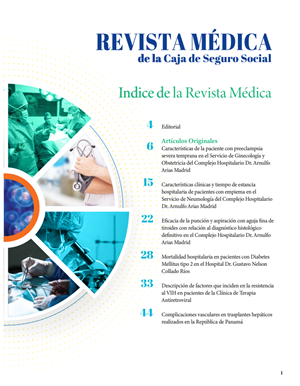CHARACTERISTICS OF THE PATIENT WITH EARLY SEVERE PREECLAMPSIA IN THE DEPARTMENT OF GYNECOLOGY AND OBSTETRICS HOSPITAL COMPLEX DR. ARNULFO ARIAS MADRID. 2015
Main Article Content
Abstract
Objective: To describe the characteristics of the patient with Early Severe Preeclampsia (ESP) in the Department of Gynecology and Obstetrics Hospital Complex Dr. Arnulfo Arias Madrid.
Materials and Methods: Observational, descriptive, retrospective and cross-sectional study. Information from clinical records of patients diagnosed with ESP that met the inclusion criteria and exclusion through capture form was collected. Frequencies and percentages were calculated, the results are presented in tables.
Results: ESP occurs most often between 18 and 35 years of age, 67.8% were nulliparous. Patients had a history of severe preeclampsia 35% and 2.4% with a history of fetal death. The most frequent pathological personal history was Chronic Hypertension 21.4%. Gestational age at diagnosis and termination of pregnancy occurs most often between 28-34 weeks. The time elapsed from the time of diagnosis until the termination of pregnancy was 7 days (0-70 days). Hypertensive crisis occurred in 16.7% of cases.
The most common indications for termination of pregnancy were symptoms of persistent vasospasm 21.4% and hypertensive crisis / intrauterine growth restriction each with 16.7%. The most frequent maternal complications were 16.7% hypertensive crisis and HELLP syndrome 7.1%. The most frequent complication was newborn small for gestational age 41.7%.
Conclusion: ESP occurs in 2% of all pregnancies, increases adverse outcomes such as preterm birth, hypertensive crisis and small for gestational age.
Downloads
Article Details
Issue
Section

This work is licensed under a Creative Commons Attribution-NonCommercial 4.0 International License.
How to Cite
References
1. Magee L, Abalos E, von Dadelszen P, Sibai B. How to manage hypetension in pregnancy effectively. Br J Clin Pharmacol 2011. 72:394–401.
2. Vigil-De Gracia P. De Gracia J. Módulo de Capacitación en Preeclampsia-Eclampsia. Federación Latinoamericana de Sociedades de Obstetricia y Ginecología 2012. 1,54.
3. Cabero, Saldívar, Cabrillo. Obstetricia y Medicina Materno Fetal. Editorial Médica Panamericana 2007. Capítulos 83, 84 y 85.
4. Vigil-De Gracia P, Lasso M, Ruíz E. Hipertensión Severa en Embarazo: Hidralazinao Labetalol. Ensayo Clínico Aleatorizado. European Journal of Obstetrics & Gynecology and Reproductive Biology 2006. 128:157–162.
5. Vigil-De Gracia et al. Manejo expectante de preeclampsia severa lejos del término: MEXPRE estudio latinoamericano, estudio clínico, multicéntrico y aleatorizado. Am J Obstetric Gynecol 2013.
6. Sibai Baha M. Evaluation and management of severe preeclampsia before 34 weeks’ gestation. Publications Committee, Society for Maternal-Fetal Medicine. American Journal of Obstetrics & Gynecology 2011.
7. Paré E, Parry S, McElrath T. Clinical Risk Factors for Preeclampsia. The American College of Obstetricians and Gynecologists. Lippincott Williams & Wilkins 2014, 124:4
8. N. Arulkumaran, L. Lightstone. Severe pre-eclampsia and hypertensive crises Best Practice & Research Clinical Obstetrics and Gynaecology 2013. 27:
877–884.
9. North RA, McCowan LM, Dekker GA, Poston L, Chan EH, Stewart AW. Clinical risk prediction for pre-eclampsia in nulliparous women: development of model in international prospective cohort. BMJ 2011;342:d1875.
10. Ananth CV, Keyes KM, Wapner RJ. Pre-eclampsia rates in the United States, 1980–2010: age-period- cohort analysis. BMJ 2013;347:f6564.
11. Gómez-Arriaga. Doppler de la Arteria Uterina y relación sFLT/PIGF: valor pronóstico en preeclampsia de aparición temprana. Ultrasound Obstet Gynecol 2014;43:525-532
12. Plasencia. Doppler de arteria uterina de las 11 a 13+6 semanas y 21 a 24+6 semanas en la predicción de preeclampsia. Ultrasound Obstet Gynecol 2008;32: 138-146
13. Sibai BM, Barton JR. Expectant management of severe preeclampsia remote from term: patient selection, treatment, and delivery indications. Am J Obstet Gynecol 2007;196:514.e1-514.e9.
14. McElrath TF, Lim KH, Pare E, Rich-Edwards J, Pucci D, Troisi R, et al. Longitudinal evaluation of predictive value for preeclampsia of circulating angiogenic factors through pregnancy. Am J Obstet Gynecol 2012;207:407.
15. Zera CA, Seely EW, Wilkins-Haug LE, Lim KH, Parry SI, McElrath TF. The association of body mass index with serum angiogenic markers in normal and abnormal pregnancies. Am J Obstet Gynecol 2014.
16. Goetzinger KR, Zhong Y, Cahill AG, Odibo L, Macones GA, Odibo AO. E ciency of first-trimester uterine artery Doppler, a-disintegrin and metalloprotease 12, pregnancy-associated plasma protein a, and maternal characteristics in the prediction of preeclampsia. J Ultrasound Med 2013;32:1593–600.
17. Myatt L, Clifton RG, Roberts JM, Spong CY, Hauth JC, Varner MW, et al. The utility of uterine artery Doppler velocimetry in prediction of preeclampsia in a low-risk population. Obstet Gynecol 2012;120:815–22.
18. Akolekar, Syngelaki, Sarquis, Nicolaides. Prediction of early, intermediate and late pre-eclampsia from maternal factors, biphysical and biochemical markers at 11-13 weeks. Prenatal Diagnosis. 2011; 31: 66-74.
19. Cunningham, Leveno, Bloom. Williams Obstetrics. Mc Graw-Hill Interamericana 24ª. 2014. Chapter 40.
20. American College of Obstetricians and Gynecologists; Task Force on Hypertension in Pregnancy. Hypertension in pregnancy. Report of the American College of Obstetricians and Gynecologists’ Task Force on Hypertension in Pregnancy. Obstet Gynecol 2013;122:1122–31.

